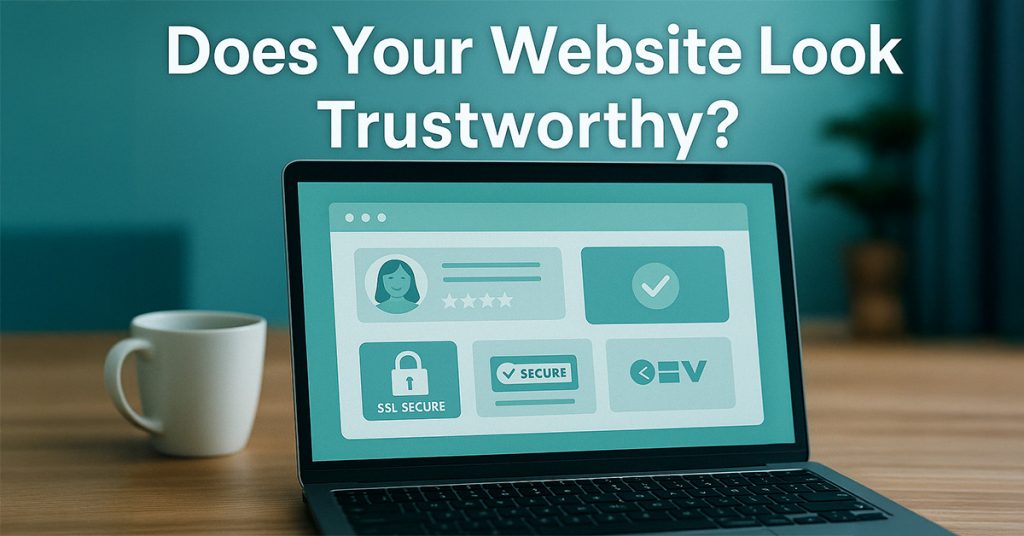
Does Your Website Look Trustworthy?
Hey there, Frank Deardurff, That One Web Guy and I’m back with another article to help you improve your online business. Today I've got a question that might just be costing you more conversions than you realize: Does your website look trustworthy?
Now, you might think, "Frank, of course my site looks trustworthy! It’s professional, clean, and does what it's supposed to." But trust me (pun fully intended), there's a whole lot more to it. Visitors landing on your website, especially those who haven't done business with you before, carry a little skepticism. They’ve got questions running through their minds like, "Is this safe? Can I trust this person or business? Is this site legitimate?"
 If your website doesn’t quickly put those worries to rest, you’re likely missing out on valuable opportunities. Let's talk about some practical strategies that you can start using right now to boost trust—and conversions—on your website.
If your website doesn’t quickly put those worries to rest, you’re likely missing out on valuable opportunities. Let's talk about some practical strategies that you can start using right now to boost trust—and conversions—on your website.
First things first: Testimonials and reviews. Nothing says "you're in good hands" quite like hearing it from someone who's already had a positive experience. Think about your own shopping habits. Before buying something online, what's the first thing you check? Reviews, right? Well, your visitors are no different.
When you include testimonials, you’re basically providing visitors with social proof—confirmation from their peers that you're legit. And here's a quick tip: always add real photos to those testimonials if you can. Photos humanize your testimonials, making them far more relatable and trustworthy. After all, would you rather trust "Jane D." or Jane Doe with a smiling photo?
Here's a stat worth noting: Websites featuring testimonials and reviews have been shown to increase conversion rates by up to 34%. That's more than a third more potential customers turning into actual customers just because they feel reassured.
Another great trust signal is displaying logos of recognizable businesses or affiliations you've worked with. Let's face it—we’re all impressed when we see someone associated with a big name we recognize. Whether it's a large corporation, a respected association, or even well-known certifications, those logos instantly communicate credibility.
For instance, if you've ever worked with big brands, attended well-known training programs, or even just belong to recognized professional groups, proudly displaying these logos tells your visitors, "Hey, reputable companies trust me, so you can too." Just be sure you're legitimately connected to these organizations—you definitely don't want to fudge this.
Next up, and often overlooked, are security badges and seals. These little guys pack a big punch in the trust department, especially if you’re running an ecommerce site. You've probably noticed the small padlock symbol next to URLs or seen badges that say "Secure Checkout" or "SSL Certified." Well, your customers notice them too—and they're essential.
Here's another interesting fact: Studies show that over 60% of consumers actively look for security badges and SSL certificates before deciding to make a purchase. Think about it—would you hand over your credit card details to a site that didn't assure you your information was safe? I didn’t think so. Make sure those badges are visible, especially during checkout.
Now, let's chat about something you might not have considered: the psychology of color. Color isn't just about aesthetics; it subconsciously communicates messages and influences our emotions. Certain colors naturally make people feel safer, calmer, and more secure.
Take blue, for instance—it's practically the international color of trust. Banks, insurance companies, and healthcare providers often use various shades of blue in their branding because it's reassuring and comforting. Green, too, can represent safety, health, and reliability. It’s why so many eco-friendly or wellness-oriented brands opt for green.
So, take a moment and step back—what colors dominate your website? If you're not leveraging trust-inducing colors like blues or greens, consider subtly integrating them into your site's design elements, especially in areas where visitors might hesitate, such as payment buttons, signup forms, or calls to action.
And speaking of calls to action—clarity here can also indirectly boost trust. When your next step is crystal clear, visitors feel more comfortable because confusion often breeds hesitation. Make your buttons straightforward and inviting, like "Secure Your Spot Now" or "Download Safely."
Remember, the core idea behind building trust signals is to reduce anxiety and uncertainty. Every small step you take toward increasing visitors’ comfort levels nudges them closer to conversion. Without these signals, you're essentially leaving potential sales sitting on the table.
In fact, a recent survey revealed that websites clearly displaying trust signals and credibility markers were seen as 48% more trustworthy by first-time visitors. That's nearly half your audience potentially feeling better about engaging with you.
Take a moment today and look at your website through the eyes of a new visitor. Are the testimonials authentic and relatable? Are your credibility logos prominently displayed? Can customers quickly see security seals and reassuring colors?
If your answer is anything other than a confident "Yes!" it's probably time to make a few tweaks.
Trust isn't built overnight, but on a website, it must happen within seconds. People buy from those they know, like, and trust. If you clearly show them why they should trust you, they'll reward you with their loyalty (and their business).
Thanks for hanging out with me today. Until next time, keep your websites trustworthy and your conversions flowing.
